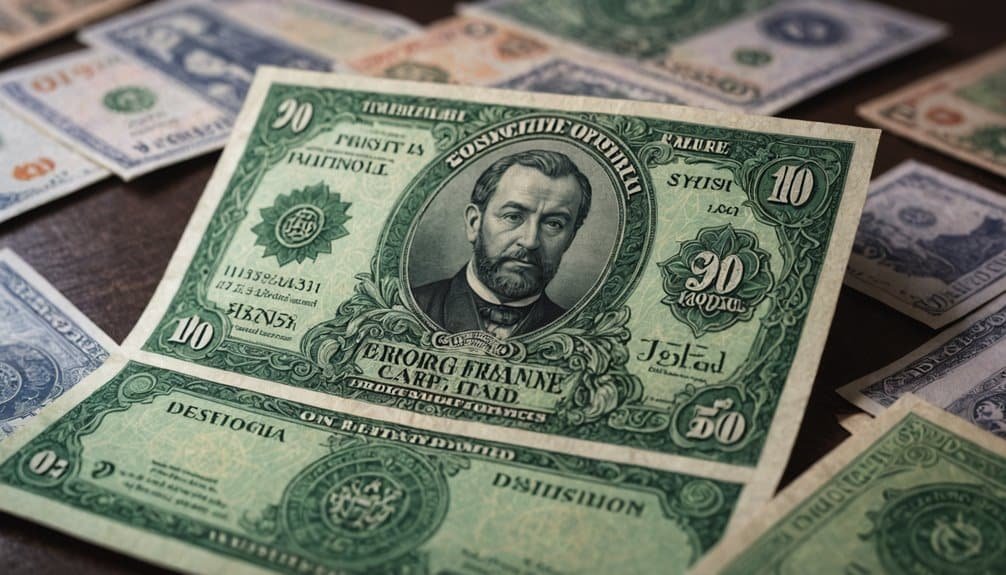
Georgia's lari, introduced in 1995, represents the nation's economic resilience and financial sovereignty. You'll find a currency designed with sophisticated security features, featuring prominent Georgian figures and cultural symbols like the Borjgali. Its exchange rate follows a managed float system, allowing dynamic market adaptations while the National Bank strategically intervenes to maintain stability. Denominations range from 5 tetri coins to 200 lari notes, each telling a piece of Georgia's complex monetary history. Key economic indicators show the lari's strength through targeted inflation control and careful foreign currency management. Curious minds will uncover deeper insights into this Caucasus monetary marvel.
Key Takeaways
- The Lari (₾) is Georgia's national currency introduced in 1995, symbolizing financial sovereignty after decades of imperial and Soviet rule.
- Currency design incorporates rich cultural elements, featuring prominent Georgian historical figures, landscapes, and security features like holographic stripes and watermarks.
- Georgia's National Bank employs a managed float exchange rate mechanism, allowing market forces to determine currency valuation while maintaining economic stability.
- Monetary policy focuses on inflation targeting (3% long-term goal), managing currency fluctuations, and reducing foreign currency dependency through strategic interventions.
- Global economic conditions and geopolitical events significantly impact Lari's value, with the central bank actively monitoring and responding to market dynamics.
Origins and Historical Development
Throughout the rich tapestry of Georgia's monetary history, currencies have been as dynamic and complex as the region's geopolitical landscape. Ancient coins reflect the region's intricate currency evolution, with diverse monetary systems influenced by Persian, Byzantine, and Ottoman empires. Regional trade networks significantly shaped the economic interactions and monetary exchanges during these historical periods.
Medieval Georgian kingdoms and principalities minted distinctive gold, silver, and copper coins, representing their economic and cultural interactions.
The shift through Russian imperial rule and Soviet occupation dramatically transformed Georgia's monetary framework. From the Russian ruble to Soviet maneti, each currency stage represented more than financial exchange—it symbolized political transformation.
When Georgia reclaimed independence in 1991, economic challenges prompted a strategic monetary change, ultimately leading to the introduction of the lari in 1995, marking a pivotal moment in the nation's financial sovereignty.
Currency Design and Denominations
Georgia's currency design reflects a rich cultural narrative through its coins and banknotes, featuring intricate security elements and historical representations.
The Lari's numismatic design incorporates portraits of significant Georgian figures and early Georgian inscriptions, transforming each monetary piece into a miniature historical artifact. The newly introduced Lari sign adds a modern graphic element that symbolizes national monetary identity and cultural pride.
Coins and Coin Design
The Georgian lari's coin system represents a nuanced monetary architecture reflecting both cultural heritage and practical economic design.
You'll find coins spanning denominations from 5 to 50 tetri and 1 to 2 lari, each embodying sophisticated design principles. Coin materials like stainless steel and bi-metallic compositions guarantee durability, while milled edges with incuse lettering enhance security and aesthetic appeal.
The design symbolism is particularly striking, with coins showcasing national iconography that captures Georgia's cultural essence. From the coat of arms to symbolic imagery like sun rays, each coin tells a narrative beyond its monetary value.
Historical series introduced in 1993 and 2006 demonstrate evolutionary improvements in coin circulation, materials, and national representation, making these small monetary units powerful ambassadors of Georgian identity. The National Bank of Georgia's pioneering efforts in establishing a unique national currency have been instrumental in shaping the country's numismatic landscape.
Banknote Security Features
Currency security represents a critical frontier in modern monetary systems, and Georgia's lari banknotes exemplify sophisticated anti-counterfeiting strategies. The 5-lari note introduced in 2017 represents a significant milestone in Georgia's currency modernization efforts.
When examining these banknotes, you'll discover latent images that emerge when tilting the note, alongside holographic stripes creating dynamic 3D visual effects.
You'll find multiple advanced protective elements integrated into their design, including UV features that reveal hidden markings under specialized light and microprinting techniques with intricate tiny text challenging reproduction.
Security threads embedded within the paper become visible when held against light, while watermark designs and iridescent stripes further enhance authentication complexity.
The Polish Security Printing Works has engineered these banknotes with exceptional precision, incorporating security fibers that illuminate under ultraviolet inspection.
These multilayered protective mechanisms guarantee the lari's integrity against potential counterfeiting attempts.
Cultural Artistic Heritage
Beyond the intricate security features that safeguard the lari's physical integrity, Georgia's currency emerges as a canvas showcasing the nation's rich cultural narrative. Each banknote serves as an artistic representation of national identity, featuring prominent historical figures like Niko Pirosmanishvili and Akaki Tsereteli against backdrops of stunning landscapes and architectural landmarks. The diverse currency denominations reflect the country's economic evolution and monetary policy adaptations.
The cultural symbolism extends to coin designs, which incorporate the Georgian coat of arms and the ancient Borjgali symbol. Denominations ranging from 1 to 200 Lari deliberately highlight regional significance, with the 200 Lari note particularly featuring multilingual inscriptions and an image of Abkhazia.
These carefully curated visual elements transform currency into a narrative medium, communicating Georgia's historical depth and cultural complexity through precise, deliberate artistic choices.
Exchange Rate Mechanisms

You'll find that Georgia's exchange rate mechanism relies on a sophisticated market-driven approach where the National Bank of Georgia strategically intervenes to maintain currency stability.
By employing a managed float system, the central bank balances market forces with calculated foreign currency transactions to mitigate excessive volatility.
This mechanism allows the lari to adapt to economic shifts while providing a controlled environment that protects against extreme exchange rate fluctuations. The NBG's approach reflects a nuanced strategy of maintaining economic monetary independence through targeted interventions.
Market Driven Valuation
Steering through Georgia's complex financial landscape reveals the intricate dynamics of the Lari's market-driven valuation mechanism.
You'll find that exchange rate fluctuations are determined by robust market demand dynamics, where commercial banks, investment funds, and corporations actively participate in setting currency value. The floating exchange rate regime allows the Lari to adjust automatically based on supply and demand, interest rates, and global economic conditions. International reserve management plays a critical role in maintaining the stability and resilience of the Lari's valuation strategy.
When you analyze the mechanism, you'll observe that the National Bank calculates the official exchange rate through weighted average transactions in the interbank foreign exchange market.
This approach guarantees transparency and reflects real-time economic forces. Cross-currency rates are sourced from reliable international information systems, providing an extensive view of the Lari's market positioning and economic potential.
Central Bank Intervention
Five critical intervention mechanisms underscore the National Bank of Georgia's strategic approach to managing the Lari's exchange rate stability.
You'll find these intervention strategies focus on addressing market pressures through targeted currency auctions, non-auction sales, and direct market interventions. When political crises or economic fluctuations threaten the Lari's value, the central bank rapidly deploys market stabilization techniques.
You'll observe their approach involves selling significant foreign currency volumes—like the $591.2 million sold in October 2024—to mitigate exchange rate volatility.
These interventions aren't random but carefully calculated responses to excess foreign currency demand and high-magnitude market shifts. By coordinating with international trading systems and using sophisticated financial instruments, the central bank maintains investor confidence and prevents drastic currency devaluations.
The central bank's recent $60 million intervention demonstrates its commitment to stabilizing the Lari during political unrest.
Currency Stability Mechanisms
The resilience of Georgia's currency hinges on sophisticated exchange rate mechanisms that dynamically respond to market complexities. Exchange rates influence trade and investment flows, making the lari's mechanism particularly crucial for economic stability.
When you examine the mechanism, you'll notice the National Bank of Georgia calculates official rates using data from Bloomberg and other financial systems.
Cross-currency rates are obtained from Reuters and international central banks, ensuring transparency and precision in currency valuation.
These mechanisms provide critical currency resilience by absorbing economic shocks, managing volatility, and supporting inflation control.
You'll find that the lari's stability relies on a floating regime where market forces—including commercial banks and investment funds—determine exchange rates through intricate interbank transactions.
Economic Significance and Impact
In light of Georgia's remarkable economic trajectory, the Lari plays a pivotal role in driving the country's financial landscape and macroeconomic stability. Currency fluctuations directly influence export competitiveness, with Lari appreciation potentially dampening international trade performance. Global monetary trends significantly shape the Lari's valuation and economic resilience.
| Economic Indicator | Impact | Trend |
|---|---|---|
| Inflation | Controlled | Declining |
| Labor Demand | High | Elevated |
| Tourism | Sensitive | Dynamic |
The Lari's value critically affects purchasing power, investment attractiveness, and sectoral dynamics. When the currency appreciates, imported inputs become cheaper, helping control inflation. Conversely, depreciation can boost export volumes while increasing import costs. Labor market tightness, characterized by 16.8% wage growth, further underscores the complex interplay between currency movements and economic fundamentals. Understanding these intricate relationships is key to comprehending Georgia's evolving economic landscape.
Monetary Policy Strategies

Although monetary policy serves as a critical lever in economic management, Georgia's National Bank (NBG) has strategically deployed sophisticated strategies to navigate complex financial landscapes.
You'll find their inflation targeting framework centered on maintaining a 3% long-term inflation rate, utilizing refined monetary transmission mechanisms that operate with a 4-6 quarter time lag.
By manipulating refinancing rates and conducting foreign exchange interventions, the NBG carefully controls economic dynamics.
Their approach involves increasing short-term interest rates to reduce loan demand, moderate consumer spending, and mitigate inflationary pressures.
The floating exchange rate regime allows flexibility, while independent policy-making guarantees decisions prioritize price stability over short-term political considerations.
These strategic monetary interventions demonstrate a nuanced understanding of economic complexity, positioning Georgia's financial management as methodical and forward-thinking. The NBG has specifically addressed high currency dollarization by implementing targeted policies to reduce foreign currency dependence and stabilize the national economy.
Global Market Influences
Extending beyond monetary policy's internal mechanisms, Georgia's Lari finds itself intricately woven into a complex global economic tapestry where international market dynamics profoundly shape its valuation.
You'll observe that global economic impact directly influences the Lari's strength, with commodity price fluctuations and geopolitical stability effects playing vital roles in its performance.
When oil prices shift or regional tensions emerge, you can expect immediate repercussions on the currency's value.
Capital flow dynamics further complicate the landscape, as international investors respond to changes in global interest rates and economic conditions.
Geopolitical events, such as conflicts in neighboring regions, can trigger significant currency movements, making the Lari particularly sensitive to external market pressures.
Understanding these interconnected global influences becomes essential for anticipating the Lari's potential trajectories. Currency exchange rates demonstrate the Lari's vulnerability to external economic pressures, with the National Bank of Georgia constantly monitoring and adjusting monetary strategies to mitigate market volatility.
Challenges and Future Outlook

Amid the complex economic landscape of Georgia, the Lari confronts a multifaceted array of challenges that will shape its trajectory in the coming years.
You'll notice that economic resilience hinges on maneuvering geopolitical tensions, managing political uncertainties, and maintaining a robust investment climate. The National Bank's strategic monetary policies and careful management of foreign exchange reserves will be critical in stabilizing currency fluctuations.
While projections suggest potential GDP growth of 9.5% in 2024 and positive institutional forecasts, you should remain cognizant of underlying risks. The continued double-digit economic growth observed in 2023 indicates the potential for sustained economic performance despite current challenges.
Depreciation pressures from reduced foreign direct investment, potential legislative changes, and regional geopolitical dynamics could impact the Lari's stability. Your understanding of these interconnected factors will be key to comprehending the currency's future performance.
Conclusion
The Lari's journey reflects Georgia's economic resilience. You've explored its complex monetary landscape, tracing transformation through challenges and opportunities. Whether analyzing exchange mechanisms or global market dynamics, you've gained insights into a currency that symbolizes national identity. Your understanding now encompasses the Lari's strategic importance, economic potential, and adaptive capacity in an evolving financial ecosystem.







Interesting read! But, dont you think the Laris design mirrors the Euro too much? Maybe an original look would boost national pride?
I wonder why the article didnt cover how Georgia’s Lari has fared against major currencies like the Dollar or Euro?